Crawling Back: Marvel Super Hero Contest of Champions Review
Marvel's first limited series/crossover event and its follow up remain narratively frustrating and forced, despite some fantastic art and action sequences
—by Nathan on December 27, 2022—
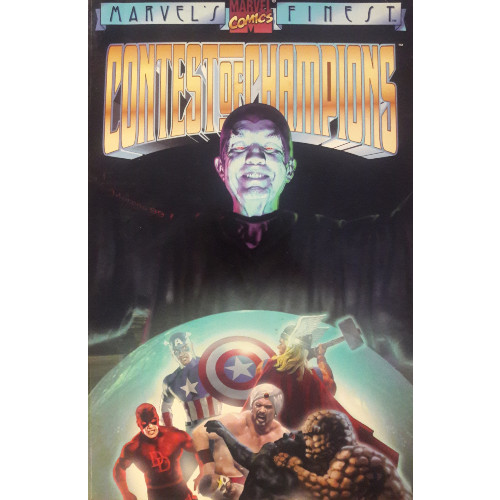
A little over two years ago, about ten posts into my “Spider-view” series, I reviewed Marvel Super Hero Secret Wars, a 12-issue limited series written by Jim Shooter and illustrated by Mike Zeck and Bob Layton. Produced between 1984 and 1985, the series promoted a line of action figures and stands as one of Marvel’s first-ever crossover epics.
But not the first-ever crossover epic.
In the intro to that post, I detailed an experience with Marvel’s original Contest of Champions series…an unfortunately negative experience. It is Contest of Champions which reigns as Marvel’s first crossover epic (meaning a story where the majority of their collective cast assembles, distinguishing it from a regular team book like Avengers or random hero interactions, like Wolverine popping up in a Spider-Man story). I picked up Contest of Champions, eager to see where it lay on the timeline, and particularly interested in witnessing where my dear friend Spider-Man fit in with the story.
He doesn’t.
I hold the original Secret Wars in high regard. It’s a personal favorite. It ain’t perfect, but on the whole, it’s a genuinely entertaining series with several memorable moments (Spidey vs. the X-Men! Doctor Doom gaining the Beyonder’s powers! The first appearance of the symbiote costume!). I had read that series for the first time a few years before and was thoroughly entertained; with that in mind, I entered Contest blindly, anticipating a repeat experience…which it wasn’t. Disillusioned and disappointed, I returned the volume I purchased.
But recently, the series has crawled its way like a miniature parasite back into my brain, itching at thoughts and sparking curiosity. I’d occasionally Google the title to see if a cheap copy of the trade paperback existed, and after a bit of digging, the search paid off. Why not give it another try? I asked myself as I added a gently used copy to my ebay shopping cart.
I have re-entered the Contest. I have given it another try. And because this story is now situated far behind where I currently am at in “Spider-view,” “Crawling Back” seems the better series to explore this narrative for the second time. So let’s leap into the past and see if I have any more respect for Contest of Champions than I did first time around.
Marvel Super Hero Contest of Champions
Writers: Bill Mantlo (with story assistance from Mark Gruenwald and Steven Grant), Steve Englehart, Tom DeFalco
Pencilers: John Romita Jr., Bob Layton, Al Milgrom, Bob Hall, Keith Pollard, Marshal Rogers, Jackson Guice, Ron Frenz
Inkers: Pablo Marcos, Al Milgrom, Tom Palmer, Bill Sienkiewicz, Al Williamson, Bob Layton, Kevin Nowlan, Bob Wiacek
Colorists: Andy Yanchus, Patricia DeFalco, Michele Wolfman, Christie Scheele, Don Warfield, Carl Gifford, Gregory Wright, Max Scheele
Letterers: Joe Rosen, Tom Orzechowski, Ken Lopez
Issues: Marvel Super Hero Contest of Champions #1-3, West Coast Avengers Annual #2, Avengers Annual #16
Volume Publication Date: August 1999
Issues Publication Dates: June 1982-August 1982, September 1987-October 1987
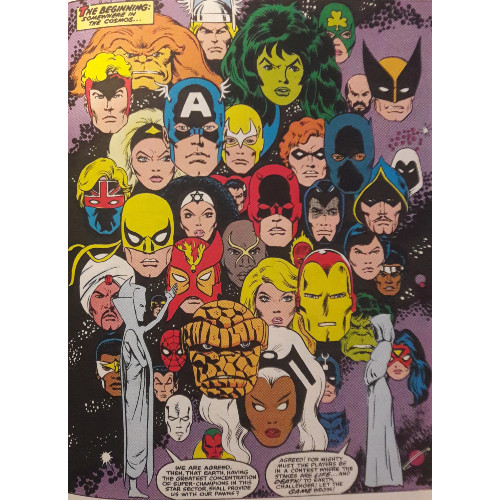
Ding-ding!
In this corner, we have a disenchanted reviewer, hackles raised, defenses up, doubt in one fist and cynicism in the other. In the other corner, his opponent–a small trade volume containing a three-part series and two Avengers annuals, the loser of the last bout but spitting in defiance and returning for potentially punishing pain. Who wins? Who loses? Who eats the mat and who stands over them, arms lifted in victory? Is this metaphor going on too long?
Probably.
I can tell you I appreciated Contest of Champions more than I did during my first read…but not by a landslide. To its credit, I finished the volume this time, actually reading the two Avengers annuals I previously skipped.
I think a certain amount of grace should be given Marvel. This was their first foray into uncharted crossover territory; never before, as I am aware, had so many characters graced the same pages before this series debuted. Again, as I mentioned, heroes popped up in each other’s books all the time, giving much-needed authenticity to the “shared universe” concept Marvel was steadily creating. By 1982, the Marvel Universe had been around for twenty years, filled with stories where Thor teamed up with the Eternals or the Avengers fought Thanos alongside Captain Marvel. The concept, at its core, was commonplace.
But the scope here feels fantastic…and is one reason why Contest fails to satisfy.
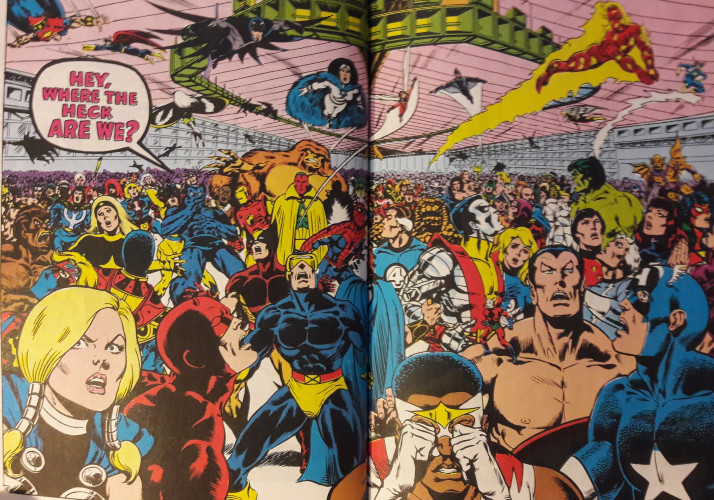
The first issue’s opening pages yank in every hero you could imagine at that point–through some cosmic shenanigans, the Avengers, the Fantastic Four, the Soviet Super Soldiers, the X-Men, Spidey, the Hulk, Alpha Flight, Doctor Strange, Daredevil, Moon Knight, the Inhumans, Thor, Daimon Hellstrom, Werewolf by Night, and a whole mess of other superhumans are plucked from Earth and sequestered into a floating space-dome. Heck, Mantlo and Romita Jr. even create new characters–like the Collective Man, Blitzkrieg, Defensor, Peregrine, Shamrock, and Talisman–all associated with different countries (the Collective Man from China, Shamrock from Ireland, etc.). A two-page spread throws familiar or significant heroes front-and-center, but amorphous blobs extend beyond visual range, suggesting a sheer suffocating amount of bodies crammed into this space. The scope is overwhelming, almost inconceivable. It’s an awesome visual to behold, but it becomes frustrating as the narrative progresses.
Our heroes have been assembled by two figures–the Elder of the Universe and cosmic DM known as the Grandmaster and a cloaked entity whose true identity is unrevealed (initially) and is referred to only as “the Unknown.” The Grandmaster and the Unknown propose a contest (how fitting) between two teams of heroes selected from the masses; each competitor selects 12 heroes, breaking them further down into four teams of three and sending each of their squadrons after a fourth of a gleaming MacGuffin called “the Golden Globe of Life.” If the Grandmaster wins (if his team collects more pieces than the other team), the Unknown will restore his then-recently-deceased brother, the Collector, to life; if the Grandmaster loses, he joins his brother in death. And if both teams fail to gather the pieces, Earth will be forever held in suspended animation.
I dislike this strongly for several reasons.
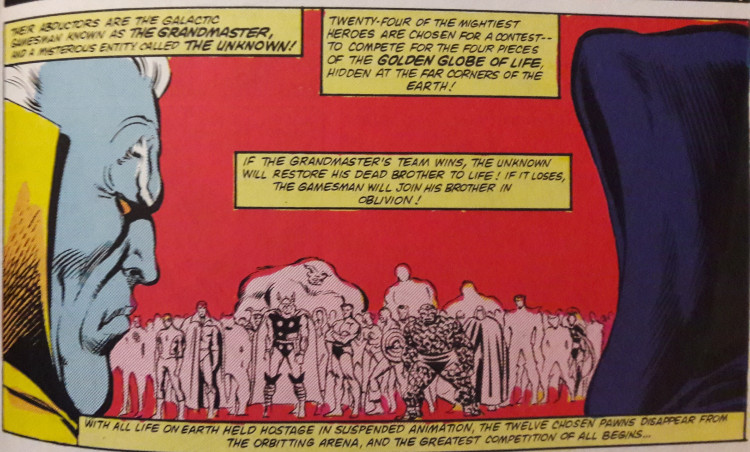
First, to whittle down an unprecedented number of superheroes down to 24 feels cheap. Admittedly, you’d never be able to tell a well-rounded story with the seemingly inexhaustible number of protagonists initially assembled–there’s no way any satisfying character development would occur if every character remained. But the first several pages offer titanic scope–each hero or team is painstakingly plucked from time and space–and the ensuing plot wastes that scope. And the Grandmaster and Unknown’s selections aren’t even that surprising. Original Avengers Thor, Iron Man, and Captain America all take part; popular mutant Wolverine is selected; the ever-lovin’ blue-eyed Thing is roped in. I suppose a few heroes are a little surprising–She-Hulk, Iron Fist, maybe Daredevil (Daredevil, but no Spidey? Really?)–but I don’t feel we’re offered an impressive or distinct cross-section of characters.
Which segues nicely into Dislike Reason #2: the Unknown throws in a rule of their own to determine this whittling. Only human participants, they declare. For the sake of fairness, natch.
What? Why?
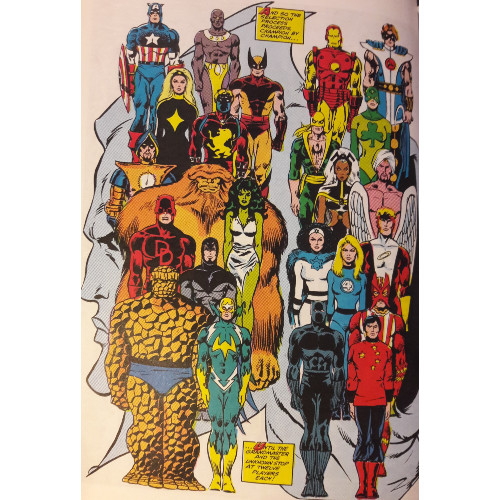
To quote the Unknown: “So that neither [side] will have any undue advantage over the other, we have disqualified all but Earth’s main race of homo sapiens–excluding from the game those immortals, Inhumans, Atlanteans, Eternals, and aliens who also occupy this world.”
So Thor? Gone. Namor? Gone. Ikaris, Sersi, and the other Eternals? Gone. Black Bolt, Medusa, and the rest of their family? Gone.
Why?
This certainly makes the selection process easier, I suppose. If you’ve only got human and mutant superheroes to choose from, you probably don’t have to throw around as many characters or invent as many fighting combos…but shouldn’t that be the fun of the series, seeing these characters collide in fancy-schmancy match-ups? I wanna see Ikaris clean the Hulk’s clock (and the real Hulk, too, not that robot two geeks created when the Eternals weren’t originally a part of the Marvel Universe!); I want Namor to go mano-a-mano against Triton of the Inhumans; I want Thor to bust some heads. And if you’ve gone to all the trouble of gathering this impressive cast of superhumans from across the face of the planet, why the heck are you sidelining the vast majority of ‘em?
But I think there’s another reason.
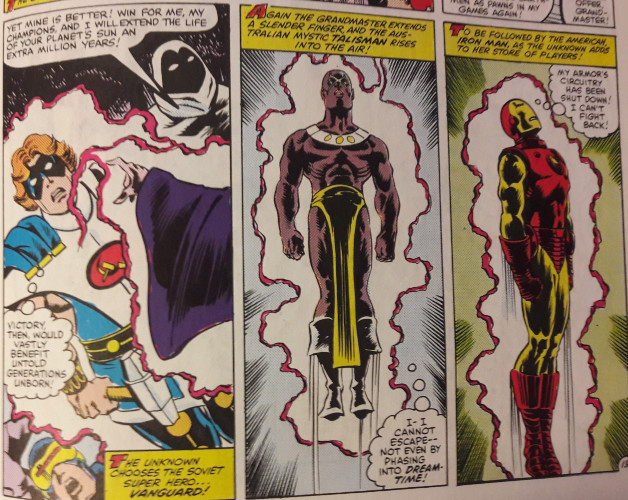
All the new characters I referenced earlier (Talisman, Peregrine, Blitzkrieg, etc.) are chosen as participating pawns. This, I assume, is to tether into Contest’s initial purpose: to tie into the 1980 Summer Olympics in Moscow. After the Soviet invasion of Afghanistan in 1979, the U.S. refused to compete, forcing Marvel to change the story’s scope. It seems logical to believe characters were originally created or selected for the Contest to represent Marvel’s cast globally. I can only assume this is why Wolverine (Canadian), Sasquatch (also Canadian), Sabra (Israeli), Arabian Knight (Arabian), Black Panther (Wakandan, which is situated in Africa), Sunfire (Japanese), Vanguard (Russian), Darkstar (Russian), and Captain Britain (British) are also chosen. The selections are not so much based on skills or strength, but on ethnicities.
I’ll admit I don’t feel totally right complaining about that–take a look at Giant-Size X-Men #1. Introducing a global scope of mutants onto the X-Men’s roster was a brilliant idea…but that’s mainly because Len Wein, Chris Claremont, Dave Cockrum, and John Byrne used those characters well. Nightcrawler, Storm, and Colossus possessed distinct personalities, strengths and weaknesses. With Contest, the idea is there, but these characters tend to come across as caricatures rather than people, especially the new heroes; this makes me even more frustrated that including these new characters is most likely one of the main reasons for the Unknown enforcing their ridiculous “only humans” rule. These new heroes don’t add much to the story, feeling shoehorned into the narrative and given little personality or motivation.
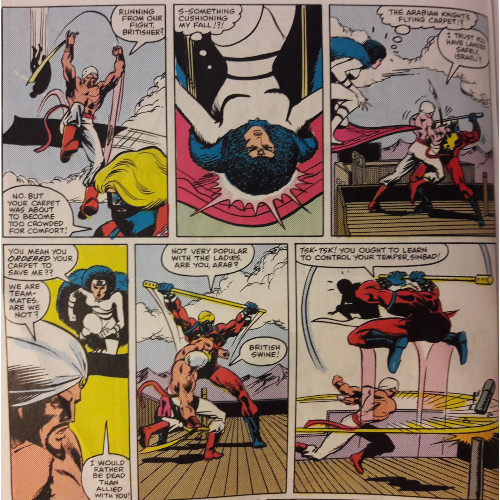
Which leads to my third issue: motivation. SPOILER alert, but the Unknown is eventually revealed as Death, Thanos’ would-be-girlfriend. She holds the Collector’s spirit hostage, and the Grandmaster competes with her, at risk of his own life, to save his brother’s soul. That’s all well and good and makes sense for the Grandmaster, but it lacks practicality for our assembled heroes. Their greatest concern is for Earth, which is held hostage by the Grandmaster and Death in the event both sides fail. So both sides fight for Earth…more clearly, both sides fight each other for Earth. We’ve got these teams in combat with one another, fighting for the same prize and to keep the same fate from befalling their home planet if they collectively lose. Does that make sense? Does that make any sense? Why are they fighting each other?
I suppose there are reasons for why alternative methods wouldn’t work. You could, hypothetically, assume that the Grandmaster and Death wouldn’t take too kindly to their pawns forming an alliance and finding the Golden Globe pieces together, thus upsetting the Contest. You could, implicitly, assume that Grandmaster and Death have some kinda backup plan were that to occur. I’m sure the creators considered that angle and, admittedly, not voicing it may have been better than frustratingly inserting needless exposition to explain all that. Still, it leaves very little room for logic. Our heroes are thrown together and all kinda just go “Why the heck not?” and start duking it over these Golden Globe pieces.
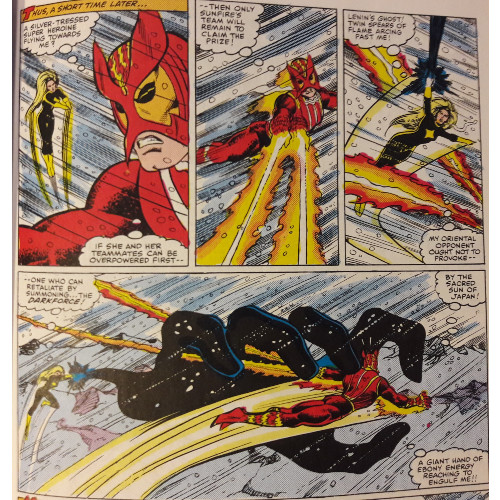
I was hoping to spot some deeper enmities or tensions this time around, deeper reasons for conflict rather than everyone serving as pawns. And the creators…try? Kinda? There’s this quasi-Cold War rhetoric woven throughout the series that’s very awkwardly inserted. Arabian Knight and Sabra can barely stand each other though they are teammates, with Sabra sniping she’d rather be dead than side with her Muslim ally. Darkstar refers to Sunfire as her “oriental opponent,” and both shout exclamations that come off as cringy forty years after their original publication (Sunfire shouts “By the sacred sun of Japan!” and “Blood of my ancestors!” while Darkstar retorts with “Lenin’s ghost!”). Again, I think the diversity of the group could have made for some compelling commentary, but characters feel resorted to stereotypes.
To their credit, the writers attempt to pair up certain opponents that feel natural–we get a pretty decent Daredevil/Iron Fist tussle, an amusing Angel/Peregrine chase sequence, and a not-half-bad Wolverine/Black Panther skirmish (though this ends awkwardly, with Wolverine totally willing to murder Panther to get the win, which is unfortunate characterization for the adamantium-entwined mutant). In other cases, pairings don't work as well–such as Sasquatch versus the Collective Man–so the fights feel occasionally forced, as if creators paired their best opponents and then mingled together the leftovers (which, y'know, is what happens when you base your cast off an agenda, but I digress). Even the Daredevil/Iron Fist pairing is made a little awkward, as Mantlo has the sparring partners behave as if they’re meeting for the first time, when both heroes had bumped into each other a few times prior to squaring off in the Contest.
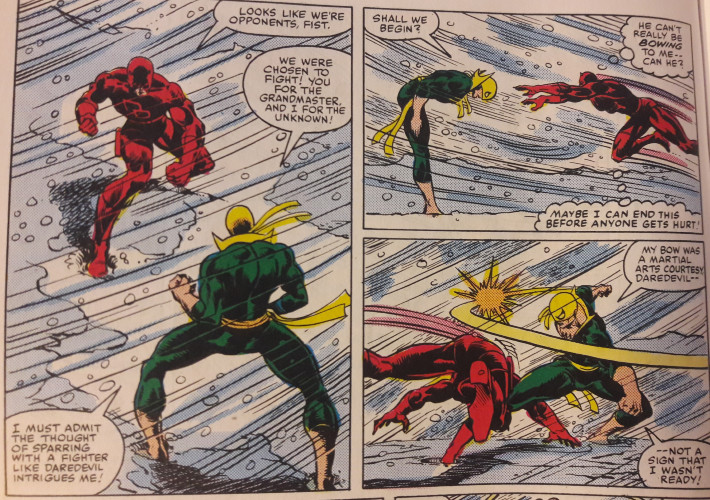
On the whole, the series is a mishmash of ideas and characters, thrown together by happenstance and driven by coincidence rather than story. And this isn’t even considering a blatant mistake near the narrative’s end that erroneously tabulates the final score; not caught prior to the third issue’s printing, this error completely upends the finale, casting it in a direction it should never logically go.
The series’ one saving grace is John Romita Jr. Contest’s first issue was published around the same time as Romita Jr.’s work on the two-part “Nothing Can Stop the Juggernaut” in Amazing Spider-Man #229-230. That narrative possesses brief shades of Romita Jr.’s current designs, but even in Contest, hints of the artist’s shifting style are evident. His faces begin bearing their distinctively angled look, his Black Panther is reminiscent of later art he’d contribute to Reginald Hudlin’s run, and even his Daredevil has similar bearings to the character he’d illustrate for Ann Nocenti and Frank Miller. Not every panel made me go “Yes, this is distinctly Romita Jr.,” but flashes sparked my recognition. He draws conflicts well, particularly those where characters are well-matched, like in the Daredevil/Iron Fist or Black Panther/Wolverine scuffles. The story may be lacking, but Romita Jr. does well with the content he’s given.
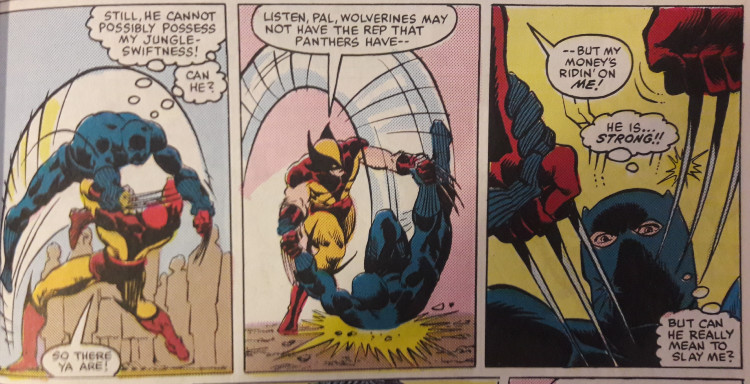
Which brings me to the volume’s second portion, the Avengers and West Coast Avengers annuals, published five years after Contest of Champions. These are better than Contest…primarily by comparison. The narrative starts off with both teams of Avengers–the “Wackos” (West Coast) and the “Eakos” (East Coast)–engaged in a friendly game of baseball (which feels lifted from the “Chris Claremont school of characterization”) before a mysterious force strikes the East Coast Avengers dead; the Silver Surfer shows up, warning them too late, and the West Coast Avengers are soon pulled into a brand new contest involving the Collector and the Grandmaster.
Steve Englehart sets up the narrative in the WCA annual, letting Tom DeFalco (and an assembly of artists) polish off the two-parter in the Avengers issue. Much like with Contest, I have some narrative problems, mainly dealing with the story’s execution. Each team is drafted by a different Elder of the Universe–the West Coast Avengers by the Collector, and the East Coast Avengers by the Grandmaster–and set against the other. I’ll admit that Englehart toys with each Elder well, giving them engaging motivations for why they’re competing against their brother, but I fail to believe each Avengers team becomes living chess pieces so easily. These guys were just playing baseball minutes ago, and while some friendly rivalry and banter can be seen, nothing in the pages preceding their individual skirmishes suggests any deep enmity. Maybe knowing some Avengers history is beneficial for understanding how quickly these guys turn on each other.
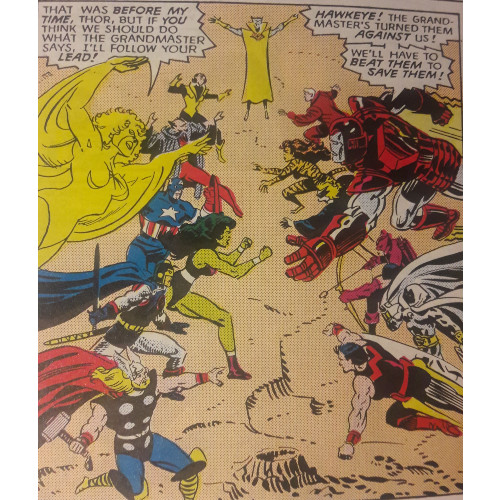
Like before, each character squares off against a specific opponent, and several of the matchups make sense–Captain America and Mockingbird are both athletes, Moon Knight and Black Knight both have magic weapons (and have “knight” in their names, I suppose), and Hank Pym and the Wasp have some bitter marital history. Others still lean into that “We paired all the logical characters, now let’s toss in the rest” quality from Contest–Hawkeye and She-Hulk don’t seem like a typical matchup, nor does Tigra and Doctor Druid (side note: I don’t think I’ve ever actually read an issue with Druid as a character, or at least not very many, but I know I’ve read people hate on him for being a lame Doctor Strange ripoff…and, holy cow, does he prove how completely useless he is here). Again, some fights are more interesting than others–if you want a really cool slugfest, pay attention to the Thor/Wonder Man brawl–but the reasoning for this sudden division between the two teams leaves me underwhelmed.
DeFalco’s issue, fortunately, is more entertaining. He offers the briefest of explanations for the plot hole deal I mentioned earlier (in, again, an underwhelming, uninspired bit of exposition) before moving the story into another contest–this time, our assembled heroes face off against a series of deceased heroes and villains assembled as the Grandmaster’s “Legion of the Unliving.” These are a variety of characters who were, at the time, deceased. Thirty-five years later, with the benefit of hindsight, some of these choices are amusing–Bucky Barnes and the Green Goblin rank among the deceased (though I suppose one could argue this is the Bart Hamilton version of the character, who was actually dead until Ben Reilly’s Jackal cloned him during The Clone Conspiracy), as do characters who would return from death after this narrative, such as the Executioner (who sacrificed himself during Walt Simonson’s run on Thor). And not to complicate matters, but research I’ve done theorizes the Grandmaster didn’t resurrect these characters but just used their likenesses, so these may be simulcra and not actual characters.
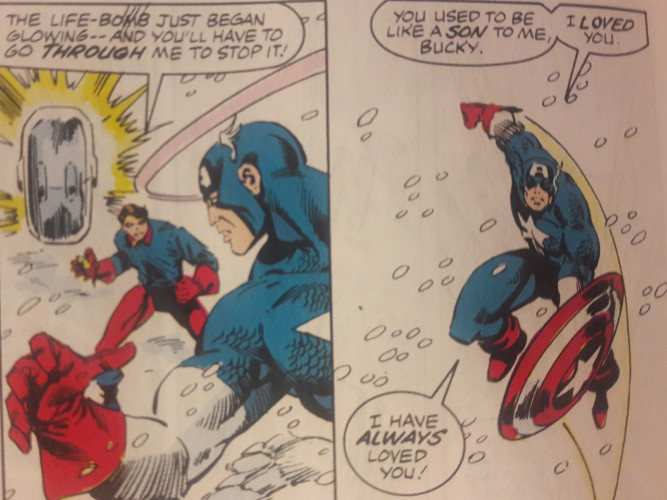
But the important part: several of these choices end up making sense and allow DeFalco and his team of artists–including a return from John Romita Jr. (whose style now hews closer to his current visuals), as well as Keith Pollard and Jackson Guice–to play with the characters in small doses. Our two teams are broken down into even smaller groupings and, now aligned, the Both Coasts Avengers (Bockos?) face adversaries more akin to their specific groupings…mostly. Again, a few decisions are out there (such as Drax the Destroyer facing She-Hulk (they’re both green, I guess?) and the Green Goblin facing Moon Knight), but several pairings are actually engaging. The Kree Captain Mar-Vell faces his “replacement,” Monica Rambeau; Thor wonders aloud why the Executioner, who sacrificed himself for the Norse god, now battles him (giving weight to the “simulcra” theory); Hawkeye and former mentor Swordsman trade barbs while crossing swords; and Captain America has to contend with a seemingly enraged Bucky, fueled by hatred for his former partner.
These are the moments which shine. They flicker sparingly, and when compared to the murkier moments when surround them, pale in number. But they are pinpricks of light, brief flashes of hope, like the last light of a star in the heavens sighted after its death.
So much of both these stories–the original Contest of Champions and these follow-up annuals–focus on the conflicts, the fights. With a title like “Contest of Champions,” what else were you gonna do? But in-between all the fisticuffs, lasers, arrows, swords, shields, and bombs, we get glimmers of unique characterization and character interactions. What does it mean for Monica Rambeau to face down a copy of the captain she replaced when he died? How does Captain America react to Bucky’s “return”? How does Thor react when the Executioner stands before him as foe after dying as friend? In Contest, we get some amusing interactions prior to the skirmishing–Defensor, Black Knight and Arabian Knight showcase their swords, Ikaris and Thor are chummy for a sec, and in a panel that gets my vote for “most unintentionally hilarious moment,” Namor the Submariner chats up Stingray and Triton, cause why shouldn’t the “can breathe underwater” characters have some connectivity?
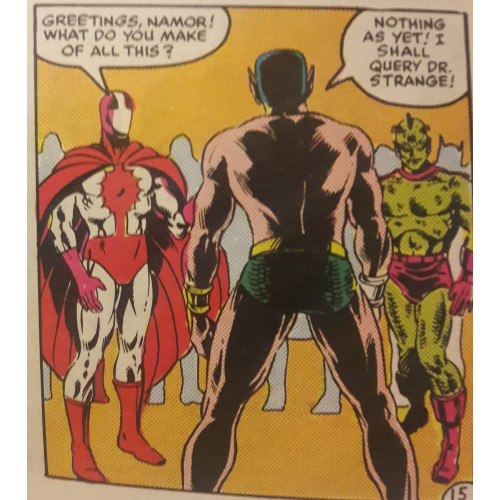
I get the reasons behind each of these stories. I understand Contest was intended to be a “Marvel superheroes participating in the Olympics” deal before the story was changed, and I know the two-annual tale was supposed to wrap up threads from Contest (even though it only kinda sorta does?). Neither narrative rings really strong, in my opinion. Story is often sacrificed for spectacle. Character gives way to physical conflict. There are clever moments, interesting tidbits, and some fairly decent art. I will note I appreciated the narrative’s use of Death as an antagonist–she’s able to stand on her own as a character, rather than just as a love interest for Thanos, and hey, it gives her something to do in the interim between that time Thanos was frozen as living stone and the moment she resurrected him.
Despite the complaining and the nitpicking, I won’t say that giving Contest a second shot was a mistake, even if I walked away only a little less underwhelmed than I was previously. Do I recommend it? Perhaps to the purist or the waist-deep collector. If you’re looking for a true contest involving some of Marvel’s greatest champions–and not just a handful of heroes slapped together with a half-dozen newbies–give the original Secret Wars a shot.

So, in the end, Contest of Champions falls again, down for the count. Its legs held it up a little longer, and it managed to evade or block a jab here and there. Heck, it even got a punch or two in. But I’ve faced fiercer fighters. Contest will have to wait a while before it can get in the ring again, and even then, it’ll never have a shot at the title.